Food & Drink
At 50 Years Old, The Cat’s Eye Pub is the Harbor’s Last True Salty-Dog Saloon
As the neighborhood changes and other long-standing bars call it quits, the Thames Street watering hole remains, with some of the best live music in town.
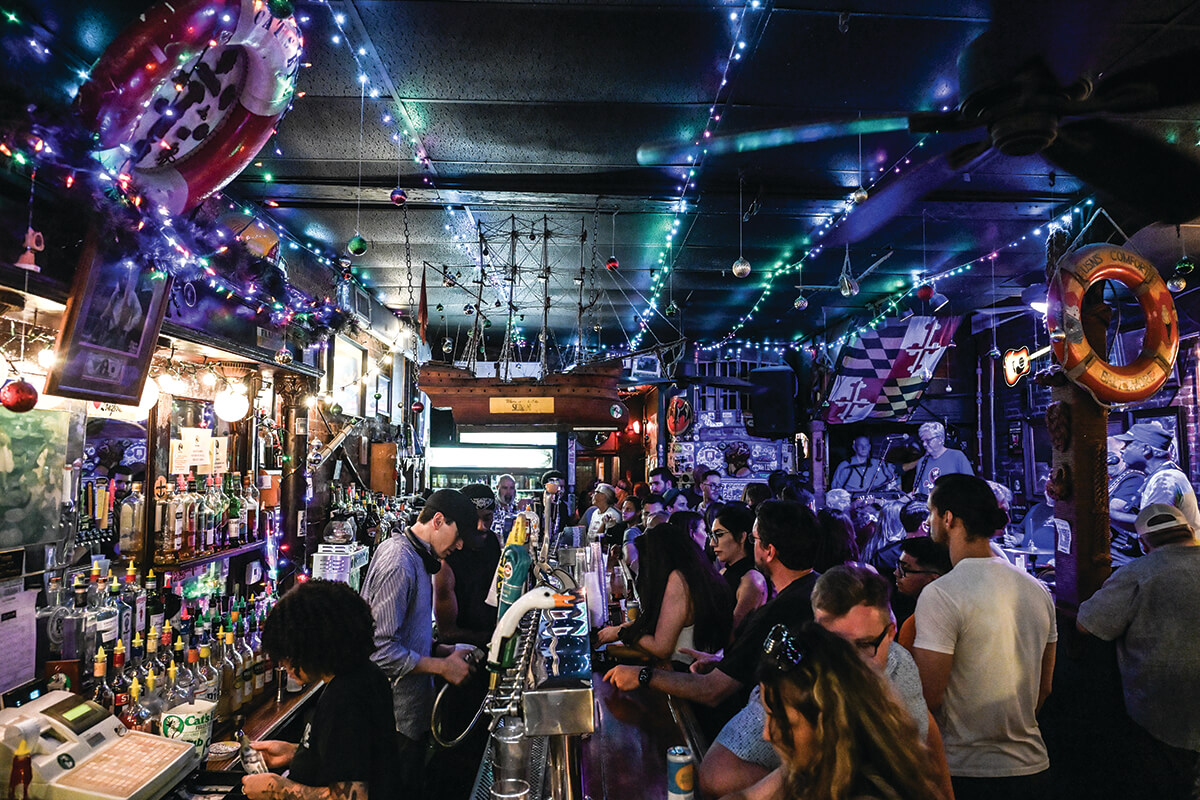
Anthony Cushing Jr. walks into a bar on Thames Street. In his standard uniform—a black ballcap, an oxford button-down, silver rings on his fingers, a medallioned chain around his neck—he slips through the crowd, greeted by a seemingly endless procession of hugs, handshakes, and “hey, Tonys!,” before dipping into the service pass for a small pour of whiskey.
As the first band of the day belts out a rockabilly rendition of “Hit the Road Jack,” he checks the cash register, chats with his bartenders, then reaches through the draft taps to kiss the ring of an older patron.
For him, this isn’t just any bar. It’s his bar. And his father’s bar before him.
“I run the circus here,” says Cushing, 41, with a wry smile, talking a mile a minute while a motley crew of customers fills the wooden stools and spreads out across the standing-room dance floor of the Cat’s Eye Pub on this cool Sunday afternoon in June. Most are here to hear the music, which graces the small corner stage seven days a week, 365 days a year, holidays included. Others have simply stopped in to see friends and have a drink. Or three.
Near the front windows, beneath the ceiling’s upside-down Christmas tree and miniature schooner, preppy twenty-somethings take shots and watch the Orioles play between Barry Glazer commercials. Closer to the graffitied bathrooms and in the low-lit backroom, a few gray-haired barflies sip their pints or read the news.
All around them is a museum’s worth of memorabilia: fading photographs, oil paintings of Fells Point’s old working waterfront, flags from around the world brought in by visiting sailors, as the Cat’s Eye—located the flick of a cigarette butt from the Baltimore harbor—has long been the city’s salty-dog watering hole.
It’s the kind of place that today’s hipsters could only wish to emulate. “But nothing in here was bought at a store, or could be replaced,” says Cushing, pointing to the murals of Irish history painted by late local artist C.W. Newton, or behind the stage, to the “Wall of Fallen Soldiers,” hung with portraits of his dad, “Big Tony,” and his original co-owner, Kenny Orye, both of whom have long since passed away.
And boy, after a half-century, if these walls could talk, they would certainly tell some stories. Same goes for Cushing, who’s run the bar for two of those decades, alongside a tight-knit staff and the pub’s matriarch, his mother, Ana Marie. Not that he’ll necessarily remember, though.
“After 21 years? I don’t know what happened yesterday,” says the boyish barkeep. “It’s Groundhog Day in here. It all blends together … But I could be fast asleep, going full Weekend at Bernie’s, and run the bar just fine.”
Still, it’s honest work, and he’s proud of it—placing the orders, tending the bar, buying a round for birthdays, sending the last stragglers home with a bottle of water, keeping the 41 keg lines clean—especially as the neighborhood changes and other long-standing businesses call it a day.
“We’re the last of the Mohicans, the last of our kind,” says Cushing. “And we’re busier now than ever.”


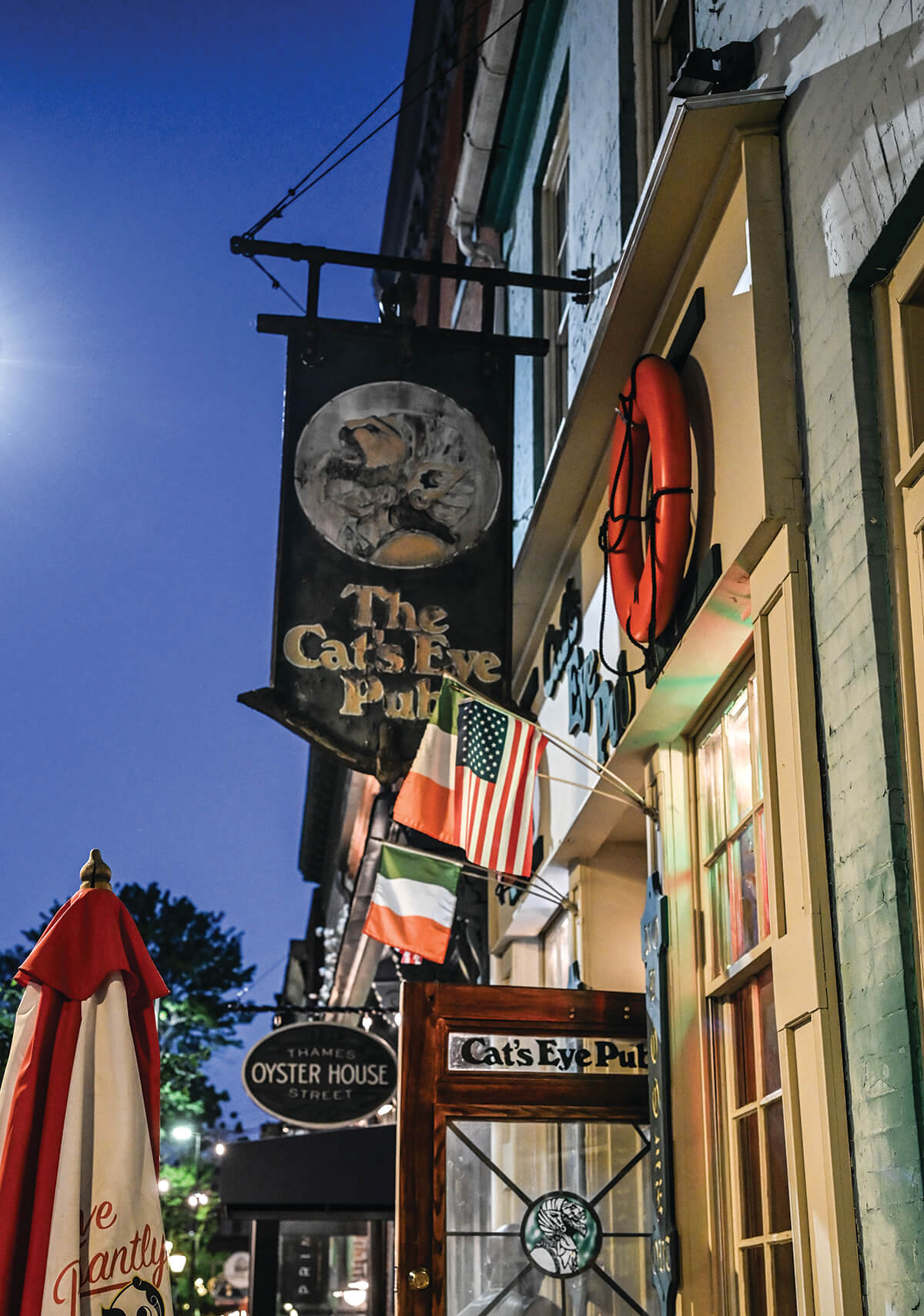
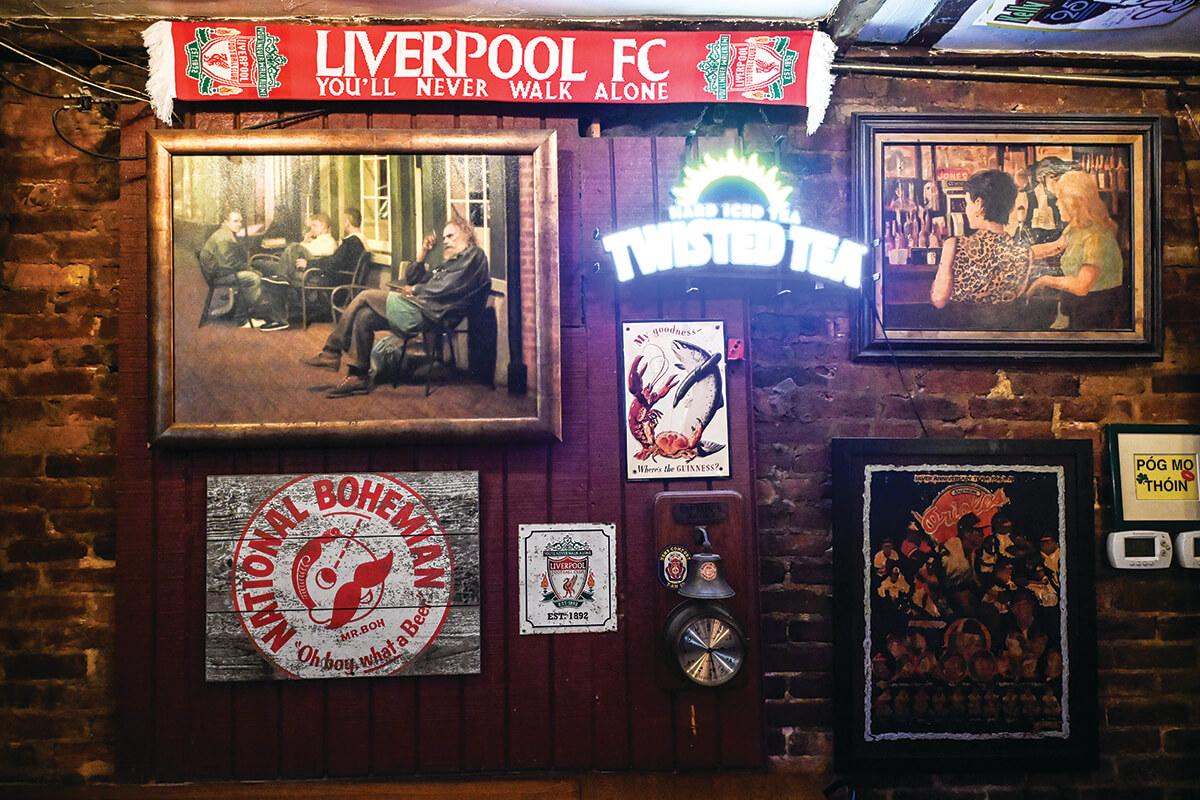
When the Cat’s Eye Pub opened in the spring of 1975, Fells Point was reveling in a moment of rebirth. Residents had just stopped the highway from cutting through their cobblestone streets, and at the water’s edge, the docks still bustled with ships and tugboats. The neighborhood was founded as Baltimore’s first port of call, thanks to its deep harbor, around which blossomed a cultural crossroads of maritime activity. From the very beginning, it was a hard-living, heavy-drinking district, full of boarding houses, brothels, and, of course, bars.
By the middle of the 20th century, you could find one on every corner, many helmed by scrappy young owners—Leadbetter’s, Bertha’s Mussels, Turkey Joe’s, Pete’s Hotel, John Steven’s, The Whistling Oyster, The Horse You Came In On (purchased with winnings from the Pimlico Race Course)—and crammed with a colorful cast of working-class characters: sailors, shift workers, drunks, punks, poets, John Waters with his entourage of eccentric artists, and, of course, the Cat’s Eye’s Kenny Orye.
“The majordomo,” says Steve Bunker, owner of the old China Sea Marine Trading shop, who arrived on the Broadway Square in ’76. “Kenny drank too much and misbehaved a lot. But he was an interesting guy. And all kinds of crazy stuff happened around that bar back then.”
“WE’RE THE LAST OF THE MOHICANS, THE LAST OF OUR KIND. AND WE’RE BUSIER NOW THAN EVER.”
Growing up near Clifton Park, Orye dropped out of high school his senior year to work in the city’s booming steel industry until coming into an inheritance. Instead of using it for college, as was his old man’s wish, the 21-year-old opened up a tavern at 1730 Thames Street with Big Tony, a Texas-born, Europe-raised military brat whom he’d met through a mutual friend. “Liquor Board Growls, And Cat’s Eye Pub Winks” declared The Baltimore Sun within their first six months, after complaints from neighbors about loud music and lewd behavior well past last call.
“It would be open sometimes until sunrise,” says Bunker, 79, a former boat captain whose parrot was known to sit on Orye’s shoulder and curse at customers. “I’d be working late and walking home. The windows would be dark, but I’d hear people inside. I’d knock on the door and Easy Eddie—a Vietnam vet, with his big moon face, who ran the back—would open it and say, ‘Bunker! Come in, man.’ The marijuana smoke would knock you over and everybody would be there. The local beat cop, the state’s attorney, illegal Irishmen, Russian sailors who’d jumped ship, drinking free booze and playing cards and telling war stories. That would go on until Kenny fell asleep at the bar, at which point Jeff Knapp, the bartender, who many say looked like Abraham Lincoln, would rob the cash register to buy us breakfast at Jimmy’s. And then it would start all over again.”
From the beginning, it was an Irish bar, as Orye held a particular soft spot for the Emerald Isle, and the IRA. Many nights, string bands played rebel tunes and seaside ballads to a full house, with other genres eventually added: jazz, blues, rock-and-roll. Beer was cheap. Whiskey flowed freely. (The Cat’s Eye was named after a West Virginia distillery where they bought moonshine in the early days.)
“We had a real saloon society back then,” says Bunker. “So many brilliant people, so many talented people, and so many sad stories, too. But a real community, where an awful lot of people showed up for a second start.”
By ’87, though, they worried the party was over, when Orye died suddenly at age 33. At the time, Big Tony had moved to Florida, and Fells Point was in the midst of a newfound real-estate boom. Forgotten rowhomes were being renovated for families, while factories and warehouses got redeveloped into condos for yuppies. Soon enough, the tugs pulled anchor, and the last of the old guard left in Fells were a few oddball shops and those seedy bars, which were increasingly changing hands and sprucing up.
In fact, with Orye out of the picture, local realtor-cum-preservationist Lucretia Fisher wanted to turn the Cat’s Eye into a tearoom.
“Of course, Kenny wouldn’t hear of it,” says Bunker, recalling the barkeep once pulling out a pistol and blowing a neon sign to bits in the front window, just to quit hearing complaints from Fisher and her county cronies. “She really thought we ought to walk around in three-corner hats and be right out of Colonial Williamsburg. … But then all of a sudden, Big Tony shows back up, and everything changed.”

Anthony Cushing Sr. wore his nickname well. Tall, thin, with a tussle of dark curls, he was larger-than-life to those who knew him, whether gregariously greeting Cat’s Eye regulars—often helping them out during hard times, too—or taking matters into his own hands, tossing troublemakers out onto Thames Street.
“He was the king of leaning in real close and telling a story right to your face,” says Sam Sessa, former nightlife reporter for the Sun, who was told tall tales about tequila-drinking bikers and a rumored second-floor whorehouse from way back when. “He was a rascal, with this sort of devilish smile. Like he was always up to something.”
A raconteur and rambling man, Big Tony ended up in Baltimore by happenstance. After graduating from the University of Maryland’s Munich campus, he worked in publishing in New York City, which in some roundabout way eventually landed him in Fells. He met his wife at 28 and opened the Cat’s Eye with Orye a few months later.
“Neither of them had ever run a bar, but both men had a lot of charm,” says Ana Marie, who, then and now, at 75, handles the business’ books. “And after Kenny died, we did whatever was necessary to make it work.”
Back from Florida with a 5-year-old “Little Tony,” the couple pulled every penny to buy that circa-1810, two-and-a-half-story rowhome building from their retiring landlord. They cleaned up the bar and built a real stage. Friends chipped in. Drinks kept flowing. At one point during repairs, the upstairs fireplace collapsed onto the first floor, sending a plume of dust out the front door. After the last brick fell, they went back inside, topped off their glasses, and carried on their conversations. True to form.
“Ron Furman of Max’s Taphouse once told me that the key to building a bar’s character is to wipe but never scrub, and that’s the Cat’s Eye,” says Sessa, who wrote Big Tony’s Sun obituary, when he died of a heart attack at 62 in 2008. “It is a prism into the past, when Fells Point was full of these gritty bars with cold beer and live music every night. It was a bit like the Wild West back then, and so much of the neighborhood has turned over now. But 50 years later, thanks to the Cushing family, the Cat’s Eye is still there.”
Can Ana Marie believe it? After all, she knows many of the old-timers are either dead or no longer drinking, some now bellying up at the Daily Grind coffee shop next door instead.
“Well … yes,” she says, matter-of-factly. “Because we didn’t give up.”
On this late-spring Sunday, musicians shuffle in—past the Cat’s Eye’s turquoise façade and two Old English signs reading “No Drugs In” and “No Booze Out”—hauling their instruments toward the stage for the afternoon’s second set. Some call that small black platform the “litter box,” and over the years, its tight quarters have become a bona fide stop for not just classic cover bands but some of the city and region’s top talent, booked by the bar’s manager, Jenn Airey. Most of the time, there’s not even a cover charge.
“You’re very much right there, in the crowd, with no distance between you, which actually makes it a great place to play,” says Bud Tiffany, 63, a guitarist with The Kindly Strangers and co-owner of Peter’s Inn, up Ann Street, with his wife, Karin. “On our days off, we always stop in to see who’s playing.”
Tonight, there’s a memorial service for a longtime regular, with an accompanying jam session. Wearing a tie-dye dress and an electric purple hairdo, Kristin Corsi wafts around the bar and waits for her turn at the mic. The local singer has been coming to the Cat’s Eye since the mid-’90s, and loves it so much, she got married here, exchanging vows in the middle of a gig with her bandmate-turned-husband, Bill.
“It’s my church,” says Corsi, who lives a few blocks away on Bank Street. “Nobody cares what you do or where you come from. And that spot, over there, in the middle of the dance floor? We call it the nexus of the universe. I’ve met people from all over the world right there. They come back years later, like, ‘You’re still here!’ Well, I’m always here … In fact, I’ve been thinking about getting a bracelet made that says, ‘If found, return to the Cat’s Eye.’”
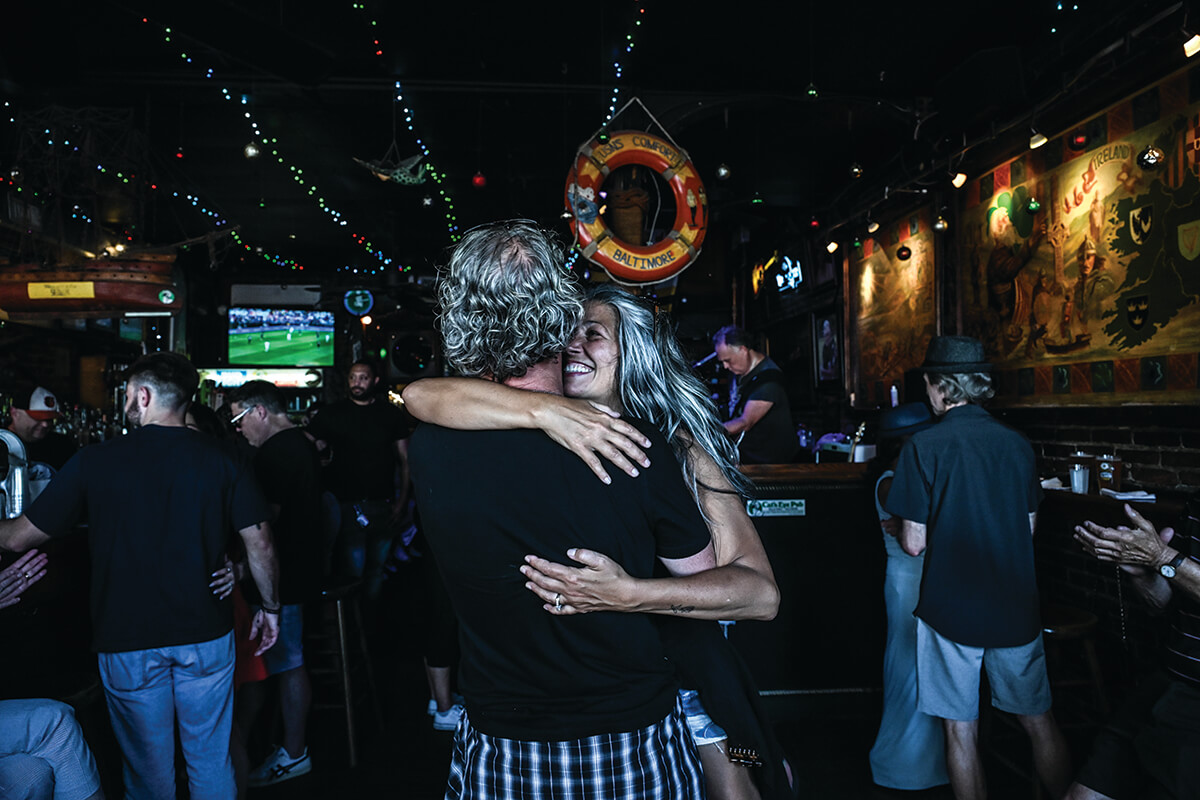
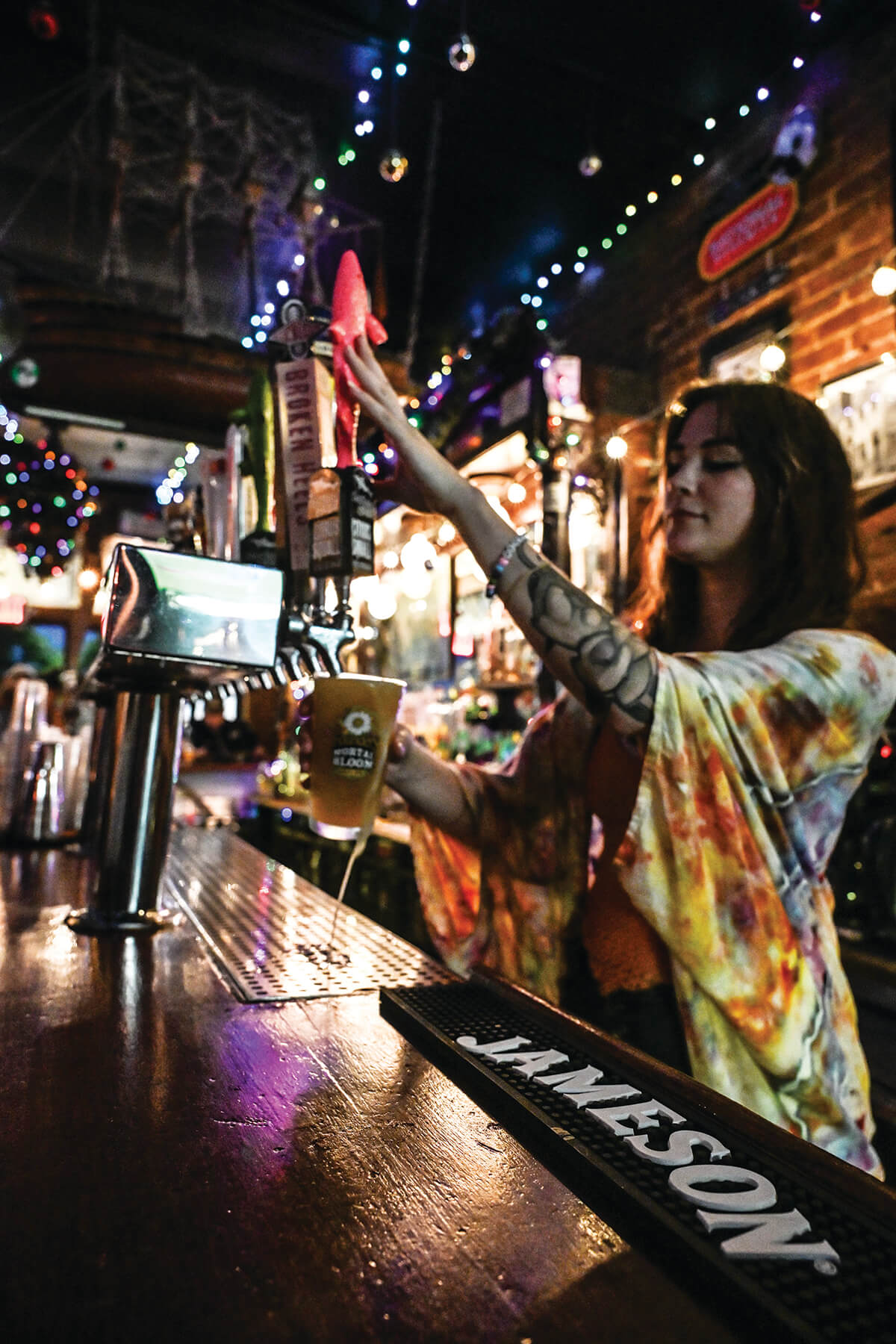
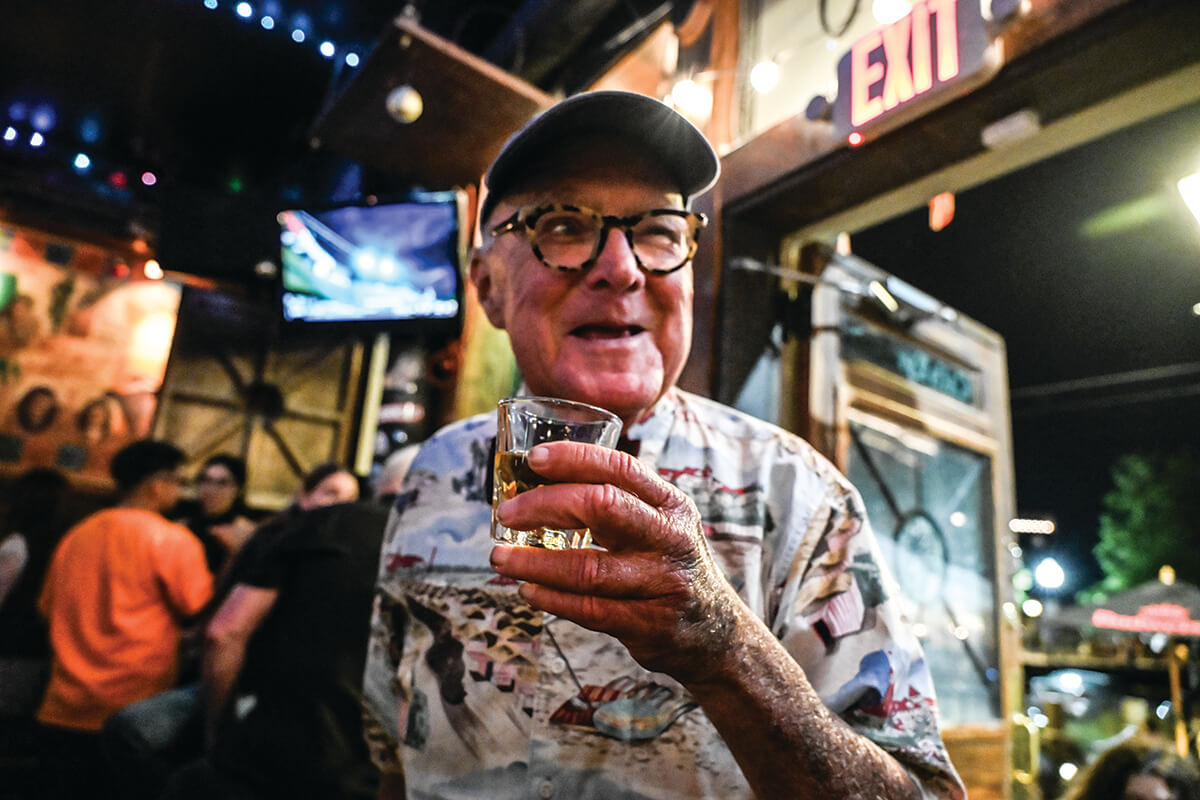
On weekends, you can often find “Bowtie” Bob Nelson bopping about, too. Many Sundays, and every St. Patrick’s Day, he attends Mass, then makes his way to Thames Street for his usual: a pint of Guinness and a Jameson, neat. He knows there’s been an influx of fancy restaurants and cocktail lounges around the neighborhood lately, but he likes the lack of pretension in this pub, where anyone and everyone can cut a rug, and the “only gourmet decision to make is if you get the plain or barbecue Utz.”
“The Cat’s Eye is something that Atlas will never be able to take over, because it just wouldn’t work,” says Nelson, 80, referring to the high-end hospitality group that’s gobbled up other stalwarts like the Waterfront Hotel and Admiral’s Cup. “You hope it’s going to be here forever.”
As the band launches into their first song, Little Tony bounces between the front and back bars, holding court beside a black-and-white photograph of him in here as a little kid, his head barely reaching the rail. In his grade-school yearbook, his dream was to “run a successful bar” one day. And by now, he’s had plenty of practice, dropping out of college to learn the ropes from Big Tony, then stepping all the way in after his father’s death.
HE LIKES THE LACK OF PRETENSION IN THIS PUB, WHERE ANYONE AND EVERYONE CAN CUT A RUG, AND THE “ONLY GOURMET DECISION TO MAKE IS IF YOU GET THE PLAIN OR BARBECUE UTZ.”
In one breath, Cushing says he’s got just under a decade left in him—and a recurring nightmare where he can’t catch up on drink orders. And yet, in the next, he’s reminiscing about his first shift, when he ran the bar all by his lonesome, then went home with a grand in tips and an adrenaline rush to last a lifetime, making it hard to imagine him anywhere else.
But sell it to some stranger with deep pockets? He’s clear on that one: “I’d rather burn the place to the fucking ground.”
Besides, he wants to finish his dad’s to-do list—the last item left being an enclosed balcony above the stage, where a 1920s pool table is already waiting. Not that there’s much time to make it happen. The bar doesn’t take a day off and slings some thousand drinks a week year-round. No matter that closing time comes early—the clock above the refrigerator is set 15 minutes ahead.
“I pay my doorman to kick me out, too,” quips Cushing. “I always thank him in the morning.”
Later, on the back patio, for a little quiet while the band grooves on, his mother straightens her blouse, sips a glass of white wine, and remembers that it’s Father’s Day.
Ana Marie still feels Big Tony all around. In fact, many believe that his ghost—along with Orye’s and that Lincoln-esque Knapp’s—still haunts the pub. Making it easy to wonder what he might think of the place these days.
She pauses, grins, then shrugs. “He’d be glad.”
Then Little Tony leans in, his eyes lighting up, just like his dad. “He’d say that we’ve done good.”